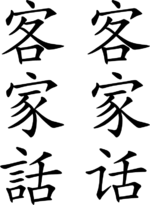ᱦᱟᱠᱠᱟ ᱯᱟᱹᱨᱥᱤ
ᱧᱮᱞᱚᱜ
(ᱦᱟᱠᱠᱟ ᱪᱟᱭᱱᱤᱡᱽ ᱠᱷᱚᱱ ᱟᱹᱪᱩᱨ ᱦᱮᱡᱠᱟᱱᱟ)
| ᱦᱟᱠᱠᱟ | |
|---|---|
| 客家話 / 客家话 Hak-kâ-fa | |
 ᱦᱟᱠ-ᱠᱟ-ᱯᱷᱟ/ᱦᱟᱠ-ᱠᱟ-ᱵᱷᱟ (Hakka/Kejia) ᱚᱞ ᱪᱟᱭᱱᱤᱡᱽ ᱟᱠᱷᱚᱨ ᱛᱮ | |
| ᱡᱟᱱᱟᱢ ᱴᱷᱟᱶ | ᱢᱩᱬᱩᱛ ᱪᱤᱱ, ᱦᱚᱝᱠᱚᱝ, ᱢᱟᱠᱟᱣ, ᱛᱟᱭᱣᱟᱱ |
| ᱮᱞᱟᱠᱟ | ᱢᱩᱬᱩᱛ ᱪᱤᱱ: ᱮᱛᱚᱢᱼᱯᱟᱪᱮ ᱜᱩᱣᱟᱝᱰᱚᱝ, ᱯᱷᱩᱡᱤᱭᱟᱝ, ᱡᱤᱭᱟᱝᱥᱤ, ᱠᱚᱧᱮ ᱦᱩᱱᱟᱱ ᱟᱨ ᱛᱟᱞᱢᱟᱼᱯᱟᱪᱮ ᱥᱤᱪᱩᱣᱟᱱ ᱨᱮᱱᱟᱜ ᱟᱰᱮᱯᱟᱥᱮ ᱴᱚᱴᱷᱟ ᱦᱚᱝᱠᱚᱝ: ᱱᱟᱶᱟ ᱴᱚᱴᱷᱟ (older generations since younger Hakkas mostly speak Cantonese due to language shift and social assimilation) |
| ᱡᱟᱹᱛ | ᱦᱟᱠᱠᱟ |
ᱡᱟᱱᱟᱢ ᱯᱟᱹᱨᱥᱤ ᱞᱮᱠᱟ | ᱔᱗.᱘ ᱢᱤᱞᱤᱭᱚᱱ (᱒᱐᱐᱗)[᱑] |
ᱪᱤᱱᱟᱼᱛᱤᱵᱵᱚᱛᱤ
| |
ᱚᱞ ᱛᱚᱦᱚᱨ | ᱦᱟᱱᱡᱤ, romanization[᱒] |
| ᱥᱚᱨᱠᱟᱨᱤ ᱢᱟᱱᱚᱛ | |
ᱟᱹᱢᱟᱹᱞᱮᱛ ᱯᱟᱹᱨᱥᱤ ᱴᱚᱴᱷᱟ | ᱛᱟᱭᱣᱟᱱ [lower-alpha ᱑] |
ᱞᱮᱠᱷᱟᱥᱤᱫ ᱯᱟᱹᱨᱥᱤ ᱢᱟᱹᱱ ᱮᱢᱟᱠᱟᱱ ᱴᱷᱟᱶ | |
| ᱯᱟᱹᱨᱥᱤ ᱠᱳᱰ | |
| ISO 639-3 | hak |
| ᱜᱞᱳᱴᱳᱞᱳᱜᱽ | hakk1236[᱖] |
| ᱯᱟᱹᱨᱥᱤ ᱴᱚᱴᱷᱟ | 79-AAA-g > 79-AAA-ga
(+ 79-AAA-gb transition to 79-AAA-h) |
 | |
ᱠᱟᱠᱠᱟ ᱫᱚ ᱢᱤᱫ ᱪᱤᱱᱟᱼᱛᱤᱵᱵᱚᱛᱤ ᱯᱟᱹᱨᱥᱤ ᱠᱟᱱᱟ ᱾ ᱱᱚᱶᱟ ᱯᱟᱹᱨᱥᱤ ᱫᱚ ᱠᱚᱧᱮ ᱪᱤᱱ, ᱛᱟᱭᱣᱟᱱ, ᱦᱚᱝᱠᱚᱝ, ᱢᱟᱠᱟᱣ ᱟᱨ ᱥᱟᱢᱟᱝ ᱮᱥᱤᱭᱟ ᱨᱮᱱ ᱦᱟᱠᱠᱟ ᱦᱚᱲ ᱠᱚᱠᱚ ᱨᱚᱲᱼᱟ ᱾
ᱧᱩᱛᱩᱢ
[ᱥᱟᱯᱲᱟᱣ | ᱯᱷᱮᱰᱟᱛ ᱥᱟᱯᱲᱟᱣ]ᱱᱟᱜᱟᱢ
[ᱥᱟᱯᱲᱟᱣ | ᱯᱷᱮᱰᱟᱛ ᱥᱟᱯᱲᱟᱣ]ᱪᱟᱸᱜᱟ ᱯᱟᱹᱨᱥᱤ ᱠᱚ
[ᱥᱟᱯᱲᱟᱣ | ᱯᱷᱮᱰᱟᱛ ᱥᱟᱯᱲᱟᱣ]ᱚᱞ ᱛᱚᱦᱚᱨ
[ᱥᱟᱯᱲᱟᱣ | ᱯᱷᱮᱰᱟᱛ ᱥᱟᱯᱲᱟᱣ]ᱢᱤᱰᱤᱭᱟ
[ᱥᱟᱯᱲᱟᱣ | ᱯᱷᱮᱰᱟᱛ ᱥᱟᱯᱲᱟᱣ]ᱟᱨᱦᱚᱸ ᱧᱮᱞ ᱢᱮ
[ᱥᱟᱯᱲᱟᱣ | ᱯᱷᱮᱰᱟᱛ ᱥᱟᱯᱲᱟᱣ]ᱵᱟᱨᱦᱮ ᱡᱚᱱᱚᱲ
[ᱥᱟᱯᱲᱟᱣ | ᱯᱷᱮᱰᱟᱛ ᱥᱟᱯᱲᱟᱣ]- Hashimoto, Mantaro J. (2010). The Hakka Dialect: A Linguistic Study of Its Phonology, Syntax and Lexicon. Princeton/Cambridge Studies in Chinese Linguistics. Vol. 5. Cambridge University Press. ISBN 978-0-521-13367-8.
- O'Connor, Kevin A. (1976). "Proto-Hakka". Ajia Afurika Gengo Bunka Kenkyū / Journal of Asia and Africa Studies. 11 (1): 1–64.
- Sagart, Laurent (1998). "On distinguishing Hakka and non-Hakka dialects". Journal of Chinese Linguistics. 26 (2): 281–302. JSTOR 23756757.
- ——— (2002). "Gan, Hakka and the Formation of Chinese Dialects" (PDF). In Ho, Dah-an (ed.). Dialect Variations in Chinese. Taipei: Academia Sinica. pp. 129–154. Archived from the original (PDF) on 2021-08-14. Retrieved 2021-01-09.
- Schaank, Simon Hartwich (1897). Het Loeh-foeng-dialect (in ᱰᱚᱪ). Leiden: E.J. Brill. Retrieved 11 February 2015.
ᱥᱟᱹᱠᱷᱭᱟᱹᱛ
[ᱥᱟᱯᱲᱟᱣ | ᱯᱷᱮᱰᱟᱛ ᱥᱟᱯᱲᱟᱣ]- ↑ ᱦᱟᱠᱠᱟ at Ethnologue (19th ed., 2016)
- ↑ Hakka was written in Chinese characters by missionaries around the turn of the 20th century.[᱑] Archived ᱒᱐᱐᱔-᱐᱘-᱒᱒ at the Wayback Machine.
- ↑ "Draft national language development act clears legislative floor". focustaiwan.tw.
- ↑ Article 6 of the Standards for Identification of Basic Language Abilities and General Knowledge of the Rights and Duties of Naturalized Citizens Archived ᱒᱐᱑᱗-᱐᱗-᱒᱕ at the Wayback Machine.
- ↑ [᱒]
- ↑ Hammarström, Harald; Forkel, Robert; Haspelmath, Martin, eds. (2017). "Hakka Chinese". Glottolog 3.0. Jena, Germany: Max Planck Institute for the Science of Human History.
{{cite book}}: Unknown parameter|chapterurl=ignored (help)
ᱛᱩᱢᱟᱹᱞ ᱦᱩᱲᱟᱹᱜ:<ref> tags exist for a group named "lower-alpha", but no corresponding <references group="lower-alpha"/> tag was found
ᱛᱷᱚᱠᱠᱩ:
- Pages with script errors
- Articles containing Chinese-language text
- Language articles with speaker number undated
- Languages without family color codes
- CS1 ᱰᱚᱪ-language sources (nl)
- ᱯᱟᱹᱨᱥᱤ
- ᱪᱤᱱᱟᱼᱛᱤᱵᱵᱚᱛᱤ ᱯᱟᱹᱨᱥᱤ
- ᱪᱤᱱ ᱨᱮᱱᱟᱜ ᱯᱟᱹᱨᱥᱤ
- ᱛᱟᱭᱣᱟᱱ ᱨᱮᱱᱟᱜ ᱯᱟᱹᱨᱥᱤ
- ᱦᱚᱝᱠᱚᱝ ᱨᱮᱱᱟᱜ ᱯᱟᱹᱨᱥᱤ
- ᱥᱤᱝᱜᱟᱯᱩᱨ ᱨᱮᱱᱟᱜ ᱯᱟᱹᱨᱥᱤ
- Language articles citing Ethnologue 19
- Webarchive template wayback links
- CS1 errors: unsupported parameter
- ᱥᱟᱦᱴᱟ ᱨᱮ ᱥᱟᱹᱠᱷᱭᱟᱹᱛ ᱠᱚ ᱵᱷᱩᱞ ᱜᱮ ᱢᱮᱱᱟᱜᱼᱟ
- Pages with reference errors that trigger visual diffs
